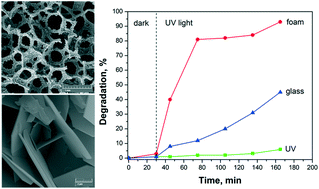Growth of ZnO nanostructures on polyurethane foam using the successive ionic layer adsorption and reaction (SILAR) method for photocatalytic applications
Abstract
ZnO nanostructures with various morphologies were grown on polyurethane foam substrates by using a chemical dipping technique called successive ionic layer adsorption and reaction (SILAR). Zn(NO3)2·6H2O complexed with NH4(OH) with pH values in the range of 8–12 and boiling deionized water were used as cationic and anionic solutions, respectively. In order to investigate the role of the number of dipping cycles on the morphology of ZnO, the deposition was carried out for 25 to 150 cycles. The characteristics of deposited films were examined by FESEM, TEM, XRD, UV-visible spectroscopy and BET techniques. The morphology of hexagonal wurtzite structured ZnO changed from nanoparticles to nanorods to nanosheets with the increase of the number of dipping cycles and the concentration of OH−/Zn2+. With the purpose of evaluating the impact of the specific surface area on the photocatalytic process efficiency, ZnO nanosheets were deposited on the bulk (glass microscope slide) substrate as well. The photocatalytic performance of ZnO nanostructures was assessed through decolorization of the aqueous solution of acid orange 7 under UV-C illumination. Despite the similar band gap energies, ZnO nanosheets grown on the porous substrate indicated 51% enhancement in the photocatalytic efficiency compared to those coated on the bulk substrate due to their higher specific surface area.


 Please wait while we load your content...
Please wait while we load your content...